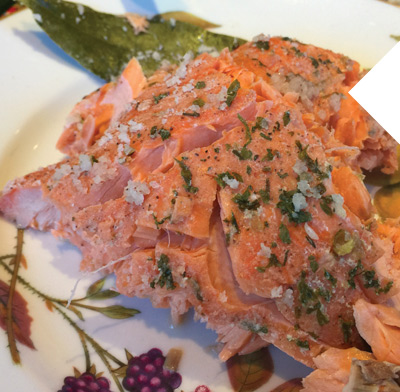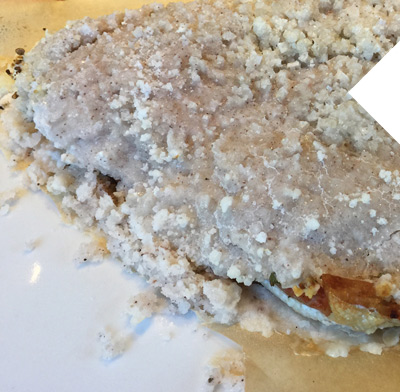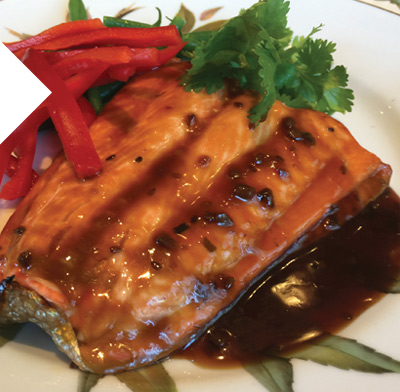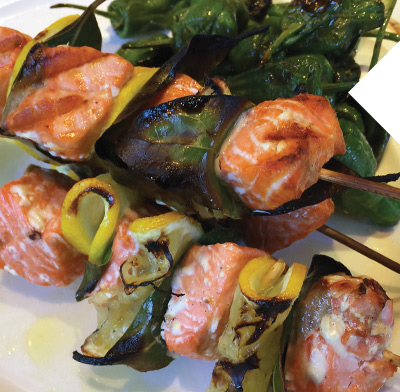The arrival of September means fall is upon us and it’s time to say goodbye to the beautiful, hot summer we enjoyed in the Pacific Northwest this year. But fall also means we are in full salmon mode. The salmon are running in Puget Sound and the market price is dropping. Is it possible to have too much salmon? Never! Now is a great time to try some different cooking techniques with the abundant salmon. Practice makes perfect!
There are five types of salmon: king (Chinook), pink (hump), sockeye (red), coho (silver), and chum (dog). They all run in the Pacific Ocean and return home, notably in Puget Sound, the Columbia River, and southeast/south Alaska. The time of year for the homecoming varies from place to place, but a good local rule of thumb is to expect some type of salmon to be running from May to October. When the salmon fisheries are open for recreational fishing depends on multiple factors, so check the Washington State Department of Fish and Wildlife for updates (wdfw.wa.gov).
If you already caught your fish, or bought your fish, handling and cooking is pretty much the same, except if you are dealing with a whole fresh-caught salmon, you will need to scale, gut, and clean the fish. When it comes time to cook the fish, are you cooking a whole fish, a filet, a steak or a portion cut of the fish?
You should always rinse your fish with cool water before cooking, and pat the fish dry using paper towels. Try to use or freeze your salmon two to three days from buying or fishing. Also, as you work on the salmon, try to keep the fish as cold as possible, don’t leave the fish out at room temperature or you are shortening the shelf life of the fish. What cut of fish is your choice. Some of the following preparations are good for a filet as well as a portion cut of fish.
There are many options for cooking salmon: roast, braise, poach, steam, bake, grill, fry, and broil. Once you develop a good repertoire of cooking skills, then it is a matter of learning about great ingredients. The best place to start exploring flavors is with herbs and vegetables. Try to stick to a specific cooking technique and practice.
Once you feel proficient, move to the next technique. You will be amazed at how your skills improve. All the techniques in the following recipes are fairly easy with few steps. When cooking salmon, keep in mind that a portion of king salmon filet is much thicker than a portion of coho or sockeye, so keep an eye on the cooking times. Cooking temperatures can vary from a high-grill heat of 500 degrees to a slower bake of 325 degrees. Regardless of the cooking, enjoy yourself, and have fun; it will show in the food!

|
Roast Salmon with a Piperade Relish
It is best to roast salmon in a 400-degree oven on a baking sheet. Put the whole salmon filet patted dry, skin on, and pin bones removed on an oiled baking sheet. Oil surface of the fish and season the top of the fish with salt and pepper. Two to three filets will take about 12 – 15 minutes to roast. Add piperade sauce (recipe below). Piperade Relish (not pictured)
Cut a small X into bottom of each tomato. Bring a pot of water to a boil, add tomatoes, and cook until skin begins to wrinkle and peel at the edges, about 30 seconds. Drain and rinse with cool water and peel skins off with your fingers. Roughly chop tomatoes and set aside. In a 12-inch skillet over medium heat, heat oil until hot, but not smoking. Add onions, peppers, and salt to sauté, stirring frequently, until onions are translucent and peppers have started to lighten in spots, about ten minutes. Add garlic and continue to sauté for another minute or so. Stir in tomatoes, sugar, and red pepper flakes. Reduce heat to medium, cover, and cook until tomatoes are starting to fall apart and peppers are soft but still hold their shape, about 15 minutes. Remove cover and continue to cook, stirring frequently until mixture thickens like a slightly runny relish, about 5 minutes more. Salt to taste. |
Salmon in Parchment
Preheat oven to 400 degrees. Unroll a 20-inch length of parchment paper and fold in half to 10 inches. Open the paper and butter the paper in the center in a 6-inch circle on one side. Season the butter with salt and pepper and place the fish on top. Season the fish, and then arrange the vegetables in a thin layer around and on top of the fish, enough for a portion. Top the fish with some herbs, drizzle with a few tablespoons of wine on top, then fold the parchment shut. Then, starting at the fold, crease and fold the paper around the entire edge to seal the packet airtight. Keep the packet level and place on a baking sheet and bake in the oven for 10 minutes. The packet should puff and turn golden brown on the top. Serve immediately, with a pair of scissors or a sharp knife to cut open the top. It is a fun and dramatic presentation! |

|

|
Salt-Crusted Salmon
It is best to roast salmon in a 400-degree oven on a sheet pan. Oil surface of the fish and season. Two to three filets will take about 12 – 15 minutes to roast. Heat oven to 400 degrees. Mound the salt around and over the filet of fish, trying to get it to make a cohesive crust over the fish (it will make removal easier later). Roast the whole filet in the oven for about 12-15 minutes for a sockeye filet, and 20-25 minutes for a thick king filet. Use a quick-read thermometer to check the temperature of the interior of the fish at the thickest point. Remove the salmon from the oven and let sit for two minutes in the crust. Carefully lift away the salt (the top will look slightly rare but the side will be cooked). Transfer to a clean work surface and finish removing salt with a pastry brush. Season with a drizzle of extra-virgin olive oil, fresh ground black pepper, and serve with a little lemon. |
Roast Salmon with a Miso, Sake, and Soy Glaze
Heat an oven to 350 degrees and place the filet of salmon on an oiled baking sheet. In a small pot, heat the sake, mirin, soy, ginger, and sugar together. Bring to a boil, reduce the heat, and simmer for ten minutes until the mixture thickens slightly. Remove from heat and stir in miso paste. Using a pastry brush, coat the surface of the fish with a thick layer of paste. Bake for ten minutes and brush again. Finish the fish in the oven until just cooked through. Garnish with sliced green onions and serve. |

|

|
Grilled Salmon Skewers
Skewer the salmon cubes, alternating with bay leaves and a folded piece of lemon (fold the ring of lemon in half to skewer the rind), then add wedges of onion between. Prepare all the skewers and chill before cooking. Heat a grill hot and brush the skewers with a small amount of oil and grill quickly, about 5 minutes total. These can be prepared in advance and held raw in the refrigerator for a day or so. |